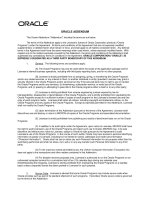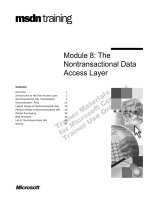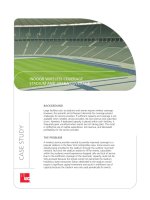Tài liệu Networking Basics - TCP/IP TRANSPORT and APPLICATION LAYER doc
Bạn đang xem bản rút gọn của tài liệu. Xem và tải ngay bản đầy đủ của tài liệu tại đây (649.55 KB, 40 trang )
Networking Basics
Networking Basics
TCP/IP TRANSPORT
TCP/IP TRANSPORT
and
and
APPLICATION LAYER
APPLICATION LAYER
Version 3.0
Cisco Regional Networking Academy
Objectives
Objectives
•
Describe the functions of the TCP/IP transport layer.
•
Describe flow control.
•
Describe the processes of establishing a connection between
peer systems.
•
Describe windowing.
•
Describe acknowledgment.
•
Identify and describe transport layer protocols.
•
Describe TCP and UDP header formats.
•
Describe TCP and UDP port numbers.
•
List the major protocols of the TCP/IP application layer.
•
Provide a brief description of the features and operation of
well-known TCP/IP applications.
Table of Content
Table of Content
1
TCP/IP Transport Layer
2
TCP/IP Application Layer
TCP/IP TRANSPORT LAYER
TCP/IP TRANSPORT LAYER
Introduction to transport layer
Introduction to transport layer
•
The primary duties of the transport layer are to transport
and regulate the flow of information from the source to the
destination, reliably and accurately.
•
The transport layer defines end-to-end connectivity between
host applications
•
Transport services include the following basic services:
–
Segmentation of upper-layer application data
–
Establishment of end-to-end operations
–
Transport of segments from one end host to another end
host
–
Flow control provided by sliding windows
–
Reliability provided by sequence numbers and
acknowledgments
Session establishment, maintenance, and termination
Session establishment, maintenance, and termination
overview
overview
•
One function of the transport layer is to establish a
connection-oriented session between similar devices at the
application layer.
Sender
Receiver
Flow control
Flow control
Sender
Receiver
TCP:
TCP:
Three way handshaking
Three way handshaking
A B
TCP:
TCP:
Window and Acknowledgment
Window and Acknowledgment
TCP:
TCP:
Sliding window and Acknowledgment
Sliding window and Acknowledgment
TCP:
TCP:
Sequence and acknowledgment
Sequence and acknowledgment
TCP:
TCP:
Sequence and acknowledgment
Sequence and acknowledgment
Transport Layer:
Transport Layer:
TCP
TCP
•
TCP supplies a reliably transportation between
end-user applications.
•
These are its characteristics:
–
Connection-oriented.
–
Supplies a virtual circuit between end-user applications
–
Breacking outgoing messages into segments and
reassembles messages at the destination.
–
Resends anything not received by acknowledgement.
–
Flow control: Windowing.
•
The protocols that use TCP include: FTP, HTTP
SMTP, Telnet.
TCP Header format
TCP Header format
R
F
C
-
7
6
1
R
F
C
-
7
6
1
TCP Header format:
TCP Header format:
Port number
Port number
•
Source Port 16 bits.
•
Destination Port 16 bits.
•
Source Port 16 bits.
•
Destination Port 16 bits.
TCP Header format:
TCP Header format:
Sequence
Sequence
•
Sequence Number: 32 bits
–
The sequence number of the
first data octet in this segment
(except when SYN is present).
•
Sequence Number: 32 bits
–
The sequence number of the
first data octet in this segment
(except when SYN is present).
TCP Header format:
TCP Header format:
Acknowledgment
Acknowledgment
•
Acknowledgment Number: 32 bits
–
This field contains the value of the
next sequence number the sender of
the segment is expecting to receive.
•
Acknowledgment Number: 32 bits
–
This field contains the value of the
next sequence number the sender of
the segment is expecting to receive.
TCP Header format:
TCP Header format:
Code bits
Code bits
•
Control Bits: 8 bits
–
ACK: Acknowledgment field significant
–
RST: Reset the connection
–
SYN: Synchronize sequence numbers
–
FIN: No more data from sender
•
Control Bits: 8 bits
–
ACK: Acknowledgment field significant
–
RST: Reset the connection
–
SYN: Synchronize sequence numbers
–
FIN: No more data from sender
TCP Header format:
TCP Header format:
Window
Window
•
Window: 16 bits
–
The number of data octets beginning
with the one indicated in the
acknowledgment field which the sender
of this segment is willing to accept.
•
Window: 16 bits
–
The number of data octets beginning
with the one indicated in the
acknowledgment field which the sender
of this segment is willing to accept.
Transport Layer:
Transport Layer:
UDP
UDP
•
UDP transports data unreliably between hosts.
Following are the characteristics:
–
Connectionless.
–
Unreliable, no software checking for message delivery
–
Transmit messages, does not need reassemble incoming
messages.
–
Without acknowledgements.
–
Error processing and retransmission must be handled by
higher layer protocols.
•
The protocols that use UDP include: TFTP, SNMP ,
DHCP ,DNS .
UDP Header format
UDP Header format
•
UDP is a simple protocol that exchanges datagrams,
without acknowledgments or guaranteed delivery.
R
F
C
-
7
6
8
R
F
C
-
7
6
8
TCP and UDP port numbers
TCP and UDP port numbers
•
Both TCP and UDP use port (or socket) numbers
to pass information to the upper layers.
R
F
C
-
1
7
0
0
R
F
C
-
1
7
0
0
Range of ports
Range of ports
•
2 bytes: 0 – 65535.
–
Numbers below 255 : for public applications.
–
Numbers from 255 - 1023 : assigned to
companies for marketable applications.
–
Numbers above 1023 : are unregulated.
•
End systems use port numbers to select proper
applications.
•
Originating source port numbers are dynamically
assigned by the source host; usually, it is a
number larger than 1023.
Telnet port number
Telnet port number
TCP/IP APPLICATIONS
TCP/IP APPLICATIONS









